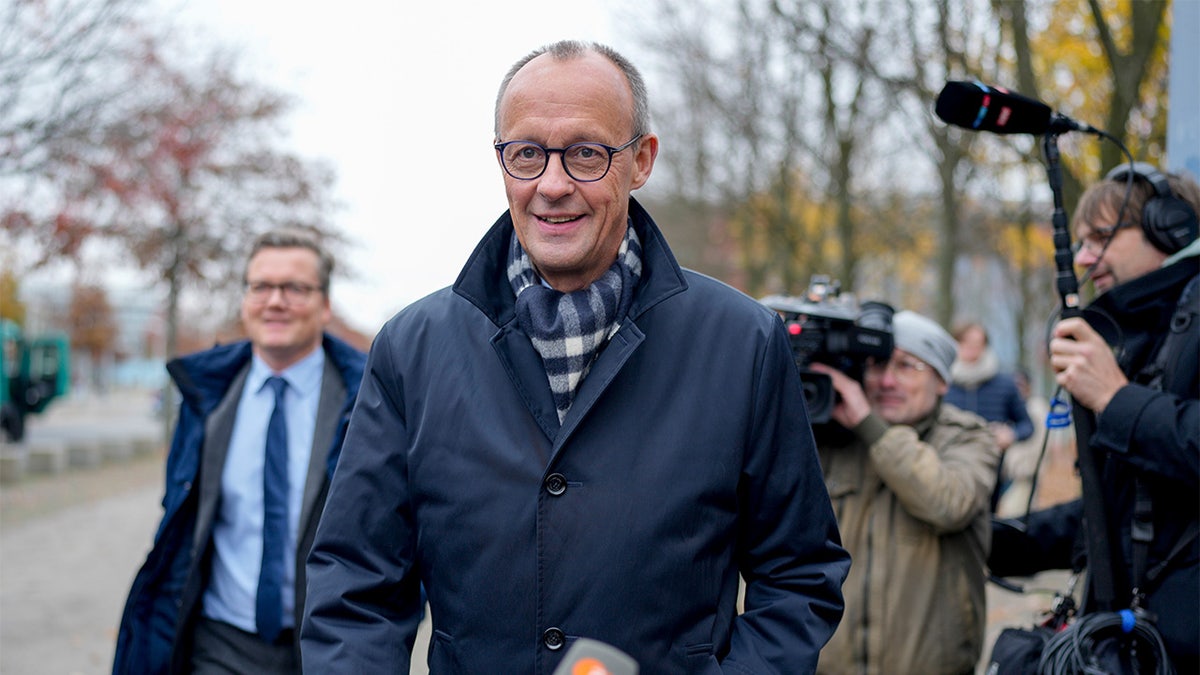INTERNACIONAL
Germany’s Scholz rejects calls for no-confidence vote as coalition government collapses

German Chancellor Olaf Scholz on Thursday rejected calls for a no-confidence vote after he fired his finance minister in a signal that his coalition government was collapsing, saying he will lead the country with a minority government until early next year.
Demands for immediate elections were issued by the leader of the largest opposition bloc in parliament, Friedrich Merz of the center-right Christian Democrats, after Scholz fired Finance Minister Christian Lindner on Wednesday for proving uncooperative in his attempts to repair the economy.
«The finance minister shows no willingness to implement the offer for the good of our country. I do not want to subject our country to such behavior anymore,» Scholz said according to an NPR report.
German Chancellor Olaf Scholz, center, leaves the Bellevue Palace in Berlin, Germany, Thursday, Nov. 7, 2024. (AP Photo/Ebrahim Noroozi)
GERMAN CHANCELLOR SCHOLZ WARNS NEXT EUROPEAN COMMISSION PRESIDENT AGAINST COURTING FAR-RIGHT SUPPORT
The move paved the way for Germany’s parliament to issue a confidence vote on Jan. 15, which is expected to lead to elections by March rather than the September timeline elections were previously set to be held . But some are calling for the proceedings to take place in 2024.
«The coalition no longer has a majority in the German Bundestag, and we therefore call on the chancellor . . . to call a vote of confidence immediately, or at the latest by the beginning of next week,» Merz said.
Scholz on Thursday stressed that he will not take steps to push the vote of confidence up any sooner than January.
«The citizens will soon have the opportunity to decide anew how to proceed,» the chancellor said according to a report by AP that cited the German Press Agency (DPA). «That is their right. I will therefore put the vote of confidence to the Bundestag at the beginning of next year.»
The finance minister was accused by Scholz of breaching his trust after Lindner publicly called for a plan that would create tax cuts worth billions for a few top earners while at the same time cutting pensions for all retirees.
«That is not decent,» Scholz said.

German opposition leader and Christian Union parties floor leader Friedrich Merz arrives for a meeting with German Chancellor Olaf Scholz at the chancellery in Berlin, Thursday, Nov.7, 2024. (AP Photo/Markus Schreiber)
FEDERAL MILITARY DRAFT AGENCY REPOSTS MESSAGE SUGGESTING US IS BECOMING 1936 NAZI GERMANY: REPORT
The economic policy disagreements reportedly arose as the coalition government – which has been in power since 2021, when Angela Markel left office – looks to plug a billion-euro hole in Germany’s 2025 budget.
Scholz is reportedly hoping that he will be able to work with his coalition government – encompassing his left-leaning Social Democrats party as well as the environmentalist Greens party – in conjunction with members of Merz’s center-right party to pass legislation in the coming weeks to address their 2025 budget gaps.
«We simply cannot afford to have a government without a majority in Germany for several months now, and then campaign for several more months, and then possibly conduct coalition negotiations for several weeks,» Merz said in objection to Scholz’s plan.

German Chancellor Angela Merkel attends a ceremony to receive the Buber-Rosenzweig medal at the Chancellery on August 30, 2021 in Berlin, Germany. (Photo by Andreas Gora – Pool/Getty Images))
CLICK HERE TO GET THE FOX NEWS APP
Given that Scholz’s party no longer holds the majority, he is expected to lose in the upcoming confidence vote, at which point Germany’s president could dissolve parliament within 21 days and force an early election as soon as January.
«During these 21 days, we will have enough time to find out whether there are any issues that we may have to decide on together,» Merz said before pledging to work cooperatively with the minority government. «We are, of course, prepared to hold talks . . . we are also prepared to take responsibility for our country.»
The Associated Press contributed to this report.
INTERNACIONAL
A tiny grain of nuclear fuel is pulled from ruined Japanese nuclear plant, in a step toward cleanup

A robot that has spent months inside the ruins of a nuclear reactor at the tsunami-hit Fukushima Daiichi plant delivered a tiny sample of melted nuclear fuel on Thursday, in what plant officials said was a step toward beginning the cleanup of hundreds of tons of melted fuel debris.
The sample, the size of a grain of rice, was placed into a secure container, marking the end of the mission, according to Tokyo Electric Power Company Holdings, which manages the plant. It is being transported to a glove box for size and weight measurements before being sent to outside laboratories for detailed analyses over the coming months.
DRONE AIMS TO EXAMINE JAPAN’S DAMAGED FUKUSHIMA NUCLEAR REACTOR FOR THE FIRST TIME
Plant chief Akira Ono has said it will provide key data to plan a decommissioning strategy, develop necessary technology and robots and learn how the accident had developed.
The first sample alone is not enough and additional small-scale sampling missions will be necessary in order to obtain more data, TEPCO spokesperson Kenichi Takahara told reporters Thursday. «It may take time, but we will steadily tackle decommissioning,» Takahara said.
Despite multiple probes in the years since the 2011 disaster that wrecked the. plant and forced thousands of nearby residents to leave their homes, much about the site’s highly radioactive interior remains a mystery.
The sample, the first to be retrieved from inside a reactor, was significantly less radioactive than expected. Officials had been concerned that it might be too radioactive to be safely tested even with heavy protective gear, and set an upper limit for removal out of the reactor. The sample came in well under the limit.
This photo released by Tokyo Electric Power Company Holdings (TEPCO), shows a robot, top right, clips a tiny gravel of what it believed to be melted fuel debris at the No. 2 reactor of the Fukushima Daiichi nuclear power plant in Okuma, Fukushima, northern Japan, on Oct. 30, 3024. (Tokyo Electric Power Company Holdings via AP)
That’s led some to question whether the robot extracted the nuclear fuel it was looking for from an area in which previous probes have detected much higher levels of radioactive contamination, but TEPCO officials insist they believe the sample is melted fuel.
The extendable robot, nicknamed Telesco, first began its mission August with a plan for a two-week round trip, after previous missions had been delayed since 2021. But progress was suspended twice due to mishaps — the first involving an assembly error that took nearly three weeks to fix, and the second a camera failure.
On Oct. 30, it clipped a sample weighting less than 3 grams (.01 ounces) from the surface of a mound of melted fuel debris sitting on the bottom of the primary containment vessel of the Unit 2 reactor, TEPCO said.
Three days later, the robot returned to an enclosed container, as workers in full hazmat gear slowly pulled it out.
On Thursday, the gravel, whose radioactivity earlier this week recorded far below the upper limit set for its environmental and health safety, was placed into a safe container for removal out of the compartment.
The sample return marks the first time the melted fuel is retrieved out of the containment vessel.
Fukushima Daiichi lost its key cooling systems during a 2011 earthquake and tsunami, causing meltdowns in its three reactors. An estimated 880 tons of fatally radioactive melted fuel remains in them.
The government and TEPCO have set a 30-to-40-year target to finish the cleanup by 2051, which experts say is overly optimistic and should be updated. Some say it would take for a century or longer.
CLICK HERE TO GET THE FOX NEWS APP
Chief Cabinet Secretary Yoshimasa Hayashi said there have been some delays but «there will be no impact on the entire decommissioning process.»
No specific plans for the full removal of the fuel debris or its final disposal have been decided.
-
POLITICA2 días ago
Ricardo Jaime se entregó en Comodoro Py: cumplirá su condena por la tragedia de Once en prisión
-
POLITICA2 días ago
Javier Milei y el gabinete felicitaron a Donald Trump: “Puede contar con Argentina para llevar a cabo su tarea”
-
POLITICA1 día ago
El Gobierno advirtió que cerrará Aerolíneas Argentinas si los gremios no frenan las medidas de fuerza
-
INTERNACIONAL2 días ago
¿A qué hora se conocerán los resultados oficiales de las elecciones en Estados Unidos 2024?
-
ECONOMIA3 días ago
Elecciones EE.UU.: El ‘arma de doble filo’ que puede alargarse en el tiempo Por Investing.com
-
ECONOMIA3 días ago
Meta mantiene la prohibición de nuevos anuncios políticos tras las elecciones Por Investing.com






























